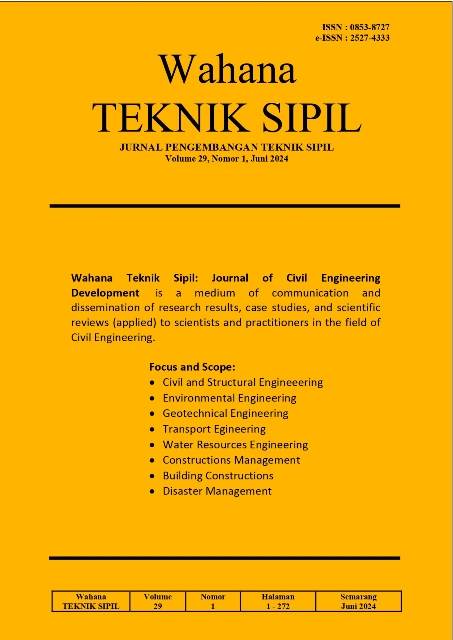TINJAUAN KUAT TEKAN DAN KANDUNGAN B3 TERLARUT DALAM BETON DENGAN AGREGAT BUATAN BERBAHAN DASAR BOTTOM ASH BATU BARA
DOI:
https://doi.org/10.32497/wahanats.v29i1.5646Keywords:
B3 waste, coal bottom ash, artificial aggregates, compressive strength, TCLP, leachingAbstract
Coal is an efficient fuel with stable heat production, so many industries use it as an energy source for the production and generation of electrical energy. Burning coal produces bottom ash waste in the combustion furnace and is categorized as B3 waste according to Government Regulation number 22 of 2021. This research is to create an alternative utilization and processing of coal bottom ash waste that is useful but still safe for the environment, namely by utilizing coal bottom ash in a ratio of 10% to 60% to sand plus cement as a binding material to form artificial aggregates, artificial aggregates are made into concrete mixtures. with a ratio of 1 cement: 2 sand and 3 artificial aggregates in the weight ratio of the materials. In this research, the maximum compressive strength value of concrete was obtained at f'c 13.89 (141.54 kg/cm2) at a ratio of 10% with a soaking time of 28 days, according to the maximum compressive strength value, coal bottom ash can be used as C quality concrete bricks. Leaching tests on 10 (ten) B3 parameters showed that Boron (B) compounds were detected above the quality standard, namely 27.62 mg/L in bottom ash, but the concentration decreased in artificial aggregates and was only 3.281 mg/L in concrete samples, while for other B3 compound parameters, the total concentration is below the specified quality standards.
References
A. Sivakumar, 2012, Pelletized Fly Ash Lightweight Aggregate Concrete: A Promising Material. Journal of Civil Engineering and Construction Technology, 3 (2), 42”“48.
Arbunowo, A.A., Purwanto, P.P., & Budihardjo, M.A., 2019, Waste to Product: Bisolum-Bricks, Incorporation of WWTP Sludge of Textile Industry Into Bricks for Wall Pairs. Jurnal Riset Teknologi Pencegahan Pencemaran Industri, 10 (2), 29”“35.
Azizah, 2018, Pemanfaatan Limbah Abu Dasar Batu Bara (Bottom Ash) sebagai Adsorben Logam Fe pada Limbah PLTU Teluk Sirih, Sumatera Barat. In Sekolah Tinggi Teknologi Industri Padang.
Basir, M., 2020, Pemanfaatan Limbah Bottom Ash sebagai Bahan Campuran Agregat Halus dengan Penambahan Tetes Tebu pada Pembuatan Beton terhadap Nilai Kuat Tekan Beton. In Universitas Pancasakti Tegal. Universitas Pancasakti Tegal.
Cadersa, A.S., Seeborun, A.K., & Chan Chim Yuk, A., 2014, Use of Coal Bottom Ash as Mechanical Stabiliser in Subgrade Soil. Journal of Engineering (United Kingdom), 2014.
Czop, M., & Åázniewska-Piekarczyk, B., 2019, Evaluation of the Leachability of Contaminations of Fly Ash and Bottom Ash from the Combustion of Solid Municipal Waste before and after Stabilization Process. Sustainability (Switzerland), 11 (19), 1”“16.
Darwis, Z., Soelarso, & Hidayat, T., 2015, Pemanfaatan Limbah Bottom Ash sebagai Substitusi Agregat Halus dalam Pembuatan Beton. 4 (1), 52”“57.
Dewi, S.U., & Prasetyo, F., 2021, Analisa Penambahan Bottom Ash terhadap Kuat Tekan dan Kuat Tarik Belah Beton. Journal of Infrastructural in Civil Engineering (JICE), 02 (02), 31”“45.
Ekaputri, J.J., & Bari, S.M.A., 2020, Perbandingan Regulasi Fly Ash sebagai Limbah B3 di Indonesia dan beberapa Negara. Media Komunikasi Teknik Sipil, 26 (2), 150”“162.
EPA, 2015, U.S. Environmental Protection Agency : FY 2013 Annual Performance Report, FY 2015 Annual Plan.
Hunt, W.F., Neligan, R.E., Curran, T.C., Faoro, R.B., Frank, N.H., & Mask, E., 1998, National Air Quality and Emissions Trends Report, 1996. United States Environmental Protection Agency, Office of Research and Development, (Report) EPA, January, 1”“164.
Kadir, A.A., Hassan, M.I.H., & Abdullah, M.M.A.B., 2016, Investigation on Leaching Behaviour of Fly Ash and Bottom Ash Replacement in Self-Compacting Concrete. IOP Conference Series: Materials Science and Engineering, 133 (1).
Kinasti, R.M.A., Lestari, E., & Mayasari, D., 2018, Potensi Pemanfaatan Limbah Pembakaran Batu Bara (Bottom Ash) Pada PLTU sebagai Media Tanam dalam Upaya Mengurangi Pencemaran Lingkungan. Jurnal Kilat, 7 (1), 36”“46.
Komala, R., Hadi, S., & Prasetiawan, J., 2021, Pengaruh Jenis Semen dan Lama Perawatan yang Berbeda terhadap Kuat Tekan Beton Normal. ANDASAH, 1 (2), 24”“32.
Kratochvil, J., Opravil, T., & DiviÅ¡, P., 2014, The Effect of Boron and its Compounds on Setting of Portland Cement. Advanced Materials Research, 1000, 16”“19.
Nuciferani, F.T., Hardjito, D., & Antoni., 2011, Pemanfaatan Bottom Ash sebagai Agregat Buatan. Jurnal Teknik Sipil, 3”“8.
Opirina, L., Sari, D.P., & Reskuna, R., 2020, Kuat Tekan Beton dengan Substitusi Limbah Pengolahan Kelapa Sawit. Jurnal CIVILLa, 5 (1), 368”“375.
PP, 2021, Peraturan Pemerintah nomor 22 tahun 2021 tentang Pedoman Perlindungan dan Pengelolaan Lingkungan Hidup. In Sekretariat Negara Republik Indonesia (Vol. 1).
Rajadesingu, S., & Arunachalam, K.D., 2020, Hydration Effect of Boric Acid on the Strength of High-Performance Concrete (HPC). IOP Conference Series: Materials Science and Engineering, 912(6).
Sari, E.K., Putri, Y.E., Lindawati, L., Desromi, F., & Nurmeyliandari, R., 2023, Ash Dan Bottom Ash Hasil Pembakaran Batu Bara PT. Bakti Nugraha Yuda Energy. Deformasi, 8 (1), 23”“30.
SNI, 2004, Semen Portland SNI 15-2049-2004. Badan Standardisasi Nasional Indonesia, 1”“128.
Wang, Q., Ko, J.H., Liu, F., & Xu, Q., 2021, Leaching Characteristics of Heavy Metals in MSW and Bottom Ash co-disposal Landfills. Journal of Hazardous Materials, 416, 126042.
WHO, 2011, Guidelines for Drinking-water Quality. Gutenberg.
Zhu, Y., Hu, Y., Guo, Q., Zhao, L., Li, L., Wang, Y., Hu, G., Wibowo, H., & Di Maio, F., 2022, The Effect of Wet Treatment on the Distribution and Leaching of Heavy Metals and Salts of Bottom Ash from Municipal Solid Waste Incineration. Environmental Engineering Science, 39 (5), 409”“417.
Downloads
Published
Issue
Section
License
Authors who publish with this journal agree to the following terms:Authors retain copyright and grant the journal right of first publication with the work simultaneously licensed under a Creative Commons Attribution License that allows others to share the work with an acknowledgement of the work's authorship and initial publication in this journal.
Authors are able to enter into separate, additional contractual arrangements for the non-exclusive distribution of the journal's published version of the work (e.g., post it to an institutional repository or publish it in a book), with an acknowledgement of its initial publication in this journal.
Authors are permitted and encouraged to post their work online (e.g., in institutional repositories or on their website) prior to and during the submission process, as it can lead to productive exchanges, as well as earlier and greater citation of published work (See The Effect of Open Access).






